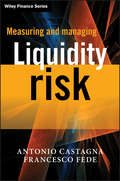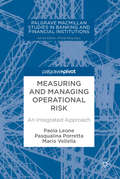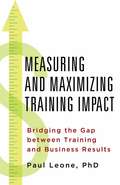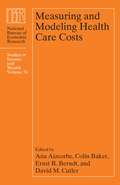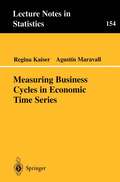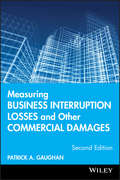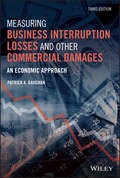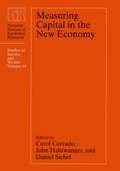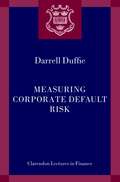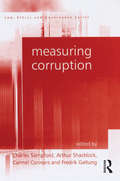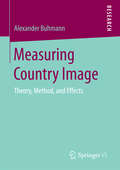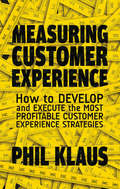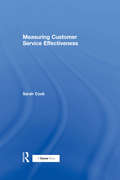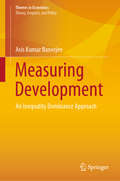- Table View
- List View
Measuring and Managing Liquidity Risk (The Wiley Finance Series)
by Antonio Castagna Francesco FedeA fully up-to-date, cutting-edge guide to the measurement and management of liquidity risk Written for front and middle office risk management and quantitative practitioners, this book provides the ground-level knowledge, tools, and techniques for effective liquidity risk management. Highly practical, though thoroughly grounded in theory, the book begins with the basics of liquidity risks and, using examples pulled from the recent financial crisis, how they manifest themselves in financial institutions. The book then goes on to look at tools which can be used to measure liquidity risk, discussing risk monitoring and the different models used, notably financial variables models, credit variables models, and behavioural variables models, and then at managing these risks. As well as looking at the tools necessary for effective measurement and management, the book also looks at and discusses current regulation and the implication of new Basel regulations on management procedures and tools.
Measuring and Managing Operational Risk
by Paola Leone Pasqualina Porretta Mario VellellaThis book covers Operational Risk Management (ORM), in the current context, and its new role in the risk management field. The concept of operational risk is subject to a wide discussion also in the field of ORM's literature, which has increased throughout the years. By analyzing different methodologies that try to integrate qualitative and quantitative data or different measurement approaches, the authors explore the methodological framework, the assumptions, statistical tool, and the main results of an operational risk model projected by intermediaries. A guide for academics and students, the book also discusses the avenue of mitigation acts, suggested by the main results of the methodologies applied. The book will appeal to students, academics, and financial supervisory and regulatory authorities.
Measuring and Managing Operational Risk: An Integrated Approach
by Paola Leone Pasqualina Porretta Mario VellellaThis book covers Operational Risk Management (ORM), in the current context, and its new role in the risk management field. The concept of operational risk is subject to a wide discussion also in the field of ORM’s literature, which has increased throughout the years. By analyzing different methodologies that try to integrate qualitative and quantitative data or different measurement approaches, the authors explore the methodological framework, the assumptions, statistical tool, and the main results of an operational risk model projected by intermediaries. A guide for academics and students, the book also discusses the avenue of mitigation acts, suggested by the main results of the methodologies applied. The book will appeal to students, academics, and financial supervisory and regulatory authorities.
Measuring and Maximizing Training Impact: Bridging the Gap between Training and Business Result
by P. LeoneThis book shows trainers how to create building blocks, construct the right linkages, and measure the impact of training programs from the first step (Level 1 – reaction) to the final destination (Level 5 – ROI). Including a new ground-breaking Level 6 exploring training sustainability, this is a must-read for HR professionals.
Measuring and Modeling Health Care Costs (National Bureau of Economic Research Studies in Income and Wealth #76)
by Ana Aizcorbe Colin Baker Ernst R. Berndt David M. CutlerHealth care costs represent a nearly 18% of U.S. gross domestic product and 20% of government spending. While there is detailed information on where these health care dollars are spent, there is much less evidence on how this spending affects health. The research in Measuring and Modeling Health Care Costs seeks to connect our knowledge of expenditures with what we are able to measure of results, probing questions of methodology, changes in the pharmaceutical industry, and the shifting landscape of physician practice. The research in this volume investigates, for example, obesity’s effect on health care spending, the effect of generic pharmaceutical releases on the market, and the disparity between disease-based and population-based spending measures. This vast and varied volume applies a range of economic tools to the analysis of health care and health outcomes. Practical and descriptive, this new volume in the Studies in Income and Wealth series is full of insights relevant to health policy students and specialists alike.
Measuring and Modeling Health Care Costs (National Bureau of Economic Research Studies in Income and Wealth #76)
by Ana Aizcorbe, Colin Baker, Ernst R. Berndt, and David M. CutlerHealth care costs represent a nearly 18% of U.S. gross domestic product and 20% of government spending. While there is detailed information on where these health care dollars are spent, there is much less evidence on how this spending affects health. The research in Measuring and Modeling Health Care Costs seeks to connect our knowledge of expenditures with what we are able to measure of results, probing questions of methodology, changes in the pharmaceutical industry, and the shifting landscape of physician practice. The research in this volume investigates, for example, obesity’s effect on health care spending, the effect of generic pharmaceutical releases on the market, and the disparity between disease-based and population-based spending measures. This vast and varied volume applies a range of economic tools to the analysis of health care and health outcomes. Practical and descriptive, this new volume in the Studies in Income and Wealth series is full of insights relevant to health policy students and specialists alike.
Measuring and Modeling Health Care Costs (National Bureau of Economic Research Studies in Income and Wealth #76)
by Ana Aizcorbe, Colin Baker, Ernst R. Berndt, and David M. CutlerHealth care costs represent a nearly 18% of U.S. gross domestic product and 20% of government spending. While there is detailed information on where these health care dollars are spent, there is much less evidence on how this spending affects health. The research in Measuring and Modeling Health Care Costs seeks to connect our knowledge of expenditures with what we are able to measure of results, probing questions of methodology, changes in the pharmaceutical industry, and the shifting landscape of physician practice. The research in this volume investigates, for example, obesity’s effect on health care spending, the effect of generic pharmaceutical releases on the market, and the disparity between disease-based and population-based spending measures. This vast and varied volume applies a range of economic tools to the analysis of health care and health outcomes. Practical and descriptive, this new volume in the Studies in Income and Wealth series is full of insights relevant to health policy students and specialists alike.
Measuring and Modeling Health Care Costs (National Bureau of Economic Research Studies in Income and Wealth #76)
Health care costs represent a nearly 18% of U.S. gross domestic product and 20% of government spending. While there is detailed information on where these health care dollars are spent, there is much less evidence on how this spending affects health. The research in Measuring and Modeling Health Care Costs seeks to connect our knowledge of expenditures with what we are able to measure of results, probing questions of methodology, changes in the pharmaceutical industry, and the shifting landscape of physician practice. The research in this volume investigates, for example, obesity’s effect on health care spending, the effect of generic pharmaceutical releases on the market, and the disparity between disease-based and population-based spending measures. This vast and varied volume applies a range of economic tools to the analysis of health care and health outcomes. Practical and descriptive, this new volume in the Studies in Income and Wealth series is full of insights relevant to health policy students and specialists alike.
Measuring Business Cycles in Economic Time Series (Lecture Notes in Statistics #154)
by Regina Kaiser Agustin MaravallThis book outlines and demonstrates problems with the use of the HP filter, and proposes an alternative strategy for inferring cyclical behavior from a time series featuring seasonal, trend, cyclical and noise components. The main innovation of the alternative strategy involves augmenting the series forecasts and back-casts obtained from an ARIMA model, and then applying the HP filter to the augmented series. Comparisons presented using artificial and actual data demonstrate the superiority of the alternative strategy.
Measuring Business Interruption Losses and Other Commercial Damages
by Patrick A. GaughanAn updated explanation of the methodology for how lost profits should be measured Now fully revised and updated, focused on commercial litigation and the many common types of cases, this is the only book in the field to explain the complicated process of measuring business interruption damages. The book features an easy to understand and apply, step-by-step process for how losses should be measured so as to be accurate and reliable and consistent with the relevant laws. With a new chapter on the economics of punitive damages, the new edition also explains detailed methods for measuring damages in contract litigation, intellectual property lawsuits, antitrust, and securities cases. This new Second Edition incorporates the latest developments in the fields of economics and accounting, while also integrating the most current changes in case law. Here's what you will find Each chapter includes new materials and updated content Added websites for sources of data Includes a website for updated tables that can be utilized by readers A section of the new cases involving Daubert challenges to economists Includes methods on how to do industry research A new section covering the equity risk premium and the various recent research studies, which set forth the debate on what the premium should be Containing exhibits, tables, and graphs, new cases involving Dauber, how to do industry research, equity risk premium, research studies on the marketability discount, anti-trust, punitive damages, and more, Measuring Business Interruption Losses and Other Commercial Damages, Second Edition incorporates the relevant literature and research that has come out in this field over the past four years.
Measuring Business Interruption Losses and Other Commercial Damages
by Patrick A. GaughanAn updated explanation of the methodology for how lost profits should be measured Now fully revised and updated, focused on commercial litigation and the many common types of cases, this is the only book in the field to explain the complicated process of measuring business interruption damages. The book features an easy to understand and apply, step-by-step process for how losses should be measured so as to be accurate and reliable and consistent with the relevant laws. With a new chapter on the economics of punitive damages, the new edition also explains detailed methods for measuring damages in contract litigation, intellectual property lawsuits, antitrust, and securities cases. This new Second Edition incorporates the latest developments in the fields of economics and accounting, while also integrating the most current changes in case law. Here's what you will find Each chapter includes new materials and updated content Added websites for sources of data Includes a website for updated tables that can be utilized by readers A section of the new cases involving Daubert challenges to economists Includes methods on how to do industry research A new section covering the equity risk premium and the various recent research studies, which set forth the debate on what the premium should be Containing exhibits, tables, and graphs, new cases involving Dauber, how to do industry research, equity risk premium, research studies on the marketability discount, anti-trust, punitive damages, and more, Measuring Business Interruption Losses and Other Commercial Damages, Second Edition incorporates the relevant literature and research that has come out in this field over the past four years.
Measuring Business Interruption Losses and Other Commercial Damages: An Economic Approach
by Patrick A. GaughanMeasure business interruption losses with confidence You hope for the best and plan for the worst. It’s your job. But when the unimaginable happens, are you truly prepared for those business interruption losses? Measuring Business Interruption Losses and Other Commercial Damages is the only book in the field that explains the complicated process of measuring business interruption damages after you’ve been hit by the unexpected, whether the losses are from natural or man-made disasters, or whether the performance of one company adversely affects the performance of another. Understand the methodology for how lost profits should be measured Deal with the many common types of cases in business interruption lawsuits in commercial litigation Take a look at exhibits, tables, and graphs Benefit from updated data, case studies, and case law references Don’t get caught off guard. Get ahead of planning for measuring your interruption losses before disaster strikes.
Measuring Business Interruption Losses and Other Commercial Damages: An Economic Approach
by Patrick A. GaughanMeasure business interruption losses with confidence You hope for the best and plan for the worst. It’s your job. But when the unimaginable happens, are you truly prepared for those business interruption losses? Measuring Business Interruption Losses and Other Commercial Damages is the only book in the field that explains the complicated process of measuring business interruption damages after you’ve been hit by the unexpected, whether the losses are from natural or man-made disasters, or whether the performance of one company adversely affects the performance of another. Understand the methodology for how lost profits should be measured Deal with the many common types of cases in business interruption lawsuits in commercial litigation Take a look at exhibits, tables, and graphs Benefit from updated data, case studies, and case law references Don’t get caught off guard. Get ahead of planning for measuring your interruption losses before disaster strikes.
Measuring Capital in the New Economy (National Bureau of Economic Research Studies in Income and Wealth #65)
by Carol Corrado John C. Haltiwanger Daniel SichelAs the accelerated technological advances of the past two decades continue to reshape the United States' economy, intangible assets and high-technology investments are taking larger roles. These developments have raised a number of concerns, such as: how do we measure intangible assets? Are we accurately appraising newer, high-technology capital? The answers to these questions have broad implications for the assessment of the economy's growth over the long term, for the pace of technological advancement in the economy, and for estimates of the nation's wealth. In Measuring Capital in the New Economy, Carol Corrado, John Haltiwanger, Daniel Sichel, and a host of distinguished collaborators offer new approaches for measuring capital in an economy that is increasingly dominated by high-technology capital and intangible assets. As the contributors show, high-tech capital and intangible assets affect the economy in ways that are notoriously difficult to appraise. In this detailed and thorough analysis of the problem and its solutions, the contributors study the nature of these relationships and provide guidance as to what factors should be included in calculations of different types of capital for economists, policymakers, and the financial and accounting communities alike.
Measuring Capital in the New Economy (National Bureau of Economic Research Studies in Income and Wealth #65)
by Corrado, Carol; Haltiwanger, John; Sichel, DanielAs the accelerated technological advances of the past two decades continue to reshape the United States' economy, intangible assets and high-technology investments are taking larger roles. These developments have raised a number of concerns, such as: how do we measure intangible assets? Are we accurately appraising newer, high-technology capital? The answers to these questions have broad implications for the assessment of the economy's growth over the long term, for the pace of technological advancement in the economy, and for estimates of the nation's wealth. In Measuring Capital in the New Economy, Carol Corrado, John Haltiwanger, Daniel Sichel, and a host of distinguished collaborators offer new approaches for measuring capital in an economy that is increasingly dominated by high-technology capital and intangible assets. As the contributors show, high-tech capital and intangible assets affect the economy in ways that are notoriously difficult to appraise. In this detailed and thorough analysis of the problem and its solutions, the contributors study the nature of these relationships and provide guidance as to what factors should be included in calculations of different types of capital for economists, policymakers, and the financial and accounting communities alike.
Measuring Capital in the New Economy (National Bureau of Economic Research Studies in Income and Wealth #65)
by Corrado, Carol; Haltiwanger, John; Sichel, DanielAs the accelerated technological advances of the past two decades continue to reshape the United States' economy, intangible assets and high-technology investments are taking larger roles. These developments have raised a number of concerns, such as: how do we measure intangible assets? Are we accurately appraising newer, high-technology capital? The answers to these questions have broad implications for the assessment of the economy's growth over the long term, for the pace of technological advancement in the economy, and for estimates of the nation's wealth. In Measuring Capital in the New Economy, Carol Corrado, John Haltiwanger, Daniel Sichel, and a host of distinguished collaborators offer new approaches for measuring capital in an economy that is increasingly dominated by high-technology capital and intangible assets. As the contributors show, high-tech capital and intangible assets affect the economy in ways that are notoriously difficult to appraise. In this detailed and thorough analysis of the problem and its solutions, the contributors study the nature of these relationships and provide guidance as to what factors should be included in calculations of different types of capital for economists, policymakers, and the financial and accounting communities alike.
Measuring Capital in the New Economy (National Bureau of Economic Research Studies in Income and Wealth #65)
by John Haltiwanger Carol Corrado Daniel SichelAs the accelerated technological advances of the past two decades continue to reshape the United States' economy, intangible assets and high-technology investments are taking larger roles. These developments have raised a number of concerns, such as: how do we measure intangible assets? Are we accurately appraising newer, high-technology capital? The answers to these questions have broad implications for the assessment of the economy's growth over the long term, for the pace of technological advancement in the economy, and for estimates of the nation's wealth. In Measuring Capital in the New Economy, Carol Corrado, John Haltiwanger, Daniel Sichel, and a host of distinguished collaborators offer new approaches for measuring capital in an economy that is increasingly dominated by high-technology capital and intangible assets. As the contributors show, high-tech capital and intangible assets affect the economy in ways that are notoriously difficult to appraise. In this detailed and thorough analysis of the problem and its solutions, the contributors study the nature of these relationships and provide guidance as to what factors should be included in calculations of different types of capital for economists, policymakers, and the financial and accounting communities alike.
Measuring Corporate Default Risk (Clarendon Lectures in Finance)
by Darrell DuffieThis book, based on the author's Clarendon Lectures in Finance, examines the empirical behaviour of corporate default risk. A new and unified statistical methodology for default prediction, based on stochastic intensity modeling, is explained and implemented with data on U.S. public corporations since 1980. Special attention is given to the measurement of correlation of default risk across firms. The underlying work was developed in a series of collaborations over roughly the past decade with Sanjiv Das, Andreas Eckner, Guillaume Horel, Nikunj Kapadia, Leandro Saita, and Ke Wang. Where possible, the content based on methodology has been separated from the substantive empirical findings, in order to provide access to the latter for those less focused on the mathematical foundations. A key finding is that corporate defaults are more clustered in time than would be suggested by their exposure to observable common or correlated risk factors. The methodology allows for hidden sources of default correlation, which are particularly important to include when estimating the likelihood that a portfolio of corporate loans will suffer large default losses. The data also reveal that a substantial amount of power for predicting the default of a corporation can be obtained from the firm's "distance to default," a volatility-adjusted measure of leverage that is the basis of the theoretical models of corporate debt pricing of Black, Scholes, and Merton. The findings are particularly relevant in the aftermath of the financial crisis, which revealed a lack of attention to the proper modelling of correlation of default risk across firms.
Measuring Corruption
by Arthur Shacklock Fredrik GaltungWith the advance of an increasingly globalized market, the opportunities for, and scale of, corruption is growing. The size of corporations and their wealth relative to nations provides the resources for corrupt practices. The liberalization of international financial markets makes transferring and hiding the proceeds of corruption easier. Moves towards privatization in East and West are providing once-only incentives for corruption on an unprecedented scale, as officials not only deal with the income of the state, but with its assets as well. In this book, Transparency International's (TI) world-renowned 'Corruption Perception Index' (CPI) and 'Bribery Perception Index' (BPI) are explained and examined by a group of experts. They set out to establish to what extent they are reliable measures of corruption and whether a series of surveys can measure changes in corruption and the effectiveness of anti-corruption strategies. The book contains a variety of expert contributions which deal with the complexity, difficulty and potential for measuring corruption as the key to developing effective strategies for combating it.
Measuring Corruption
by Arthur Shacklock Fredrik GaltungWith the advance of an increasingly globalized market, the opportunities for, and scale of, corruption is growing. The size of corporations and their wealth relative to nations provides the resources for corrupt practices. The liberalization of international financial markets makes transferring and hiding the proceeds of corruption easier. Moves towards privatization in East and West are providing once-only incentives for corruption on an unprecedented scale, as officials not only deal with the income of the state, but with its assets as well. In this book, Transparency International's (TI) world-renowned 'Corruption Perception Index' (CPI) and 'Bribery Perception Index' (BPI) are explained and examined by a group of experts. They set out to establish to what extent they are reliable measures of corruption and whether a series of surveys can measure changes in corruption and the effectiveness of anti-corruption strategies. The book contains a variety of expert contributions which deal with the complexity, difficulty and potential for measuring corruption as the key to developing effective strategies for combating it.
Measuring Country Image: Theory, Method, and Effects
by Alexander BuhmannAlexander Buhmann develops a new model for measuring the constitution and effects of country images by combining well-established concepts from national identity theory and attitude theory with a recent model from reputation management. The model is operationalized and tested in two surveys. Results show how different cognitive and affective dimensions of the country image affect each other and ultimately lead to the facilitation of behavioral intentions. The book introduces a theory-grounded approach to clarify the dimensionality of the country image. It is the first to operationalize and test the dimensions of the country image by combining formative and reflective measures in a mixed-specified model.
Measuring Customer Experience: How to Develop and Execute the Most Profitable Customer Experience Strategies
by Philipp KlausNow, more than ever, customer experience plays a pivotal role in the success and longevity of a company. Based on rigorous scientific tools and global data, this book offers a simple but thorough guide on how to master the challenges of the market, and how to deliver superior performance through effective customer experience management.
Measuring Customer Service Effectiveness
by Sarah CookGood customer service may be seen as a crucial asset for most organisations. But how do you know that you are delivering good customer service both externally and internally and, more importantly, delivering it to meet and exceed your customers' expectations? Customer service is an intangible thing, it is perishable and it is personal, so measuring it can be complicated and less than straightforward. Help is at hand. Sarah Cook's down-to-earth guide provides the rationale behind measuring service effectiveness externally and internally and explains the measurement process, from preparation to managing the results. The book also includes an exploration of the various techniques open for measuring effectiveness and how to use them. Utilising her consultancy experiences the author has ensured that there is plenty of ready-to-use materials to enable you to start measuring your own organisation's service effectiveness straight away.
Measuring Customer Service Effectiveness
by Sarah CookGood customer service may be seen as a crucial asset for most organisations. But how do you know that you are delivering good customer service both externally and internally and, more importantly, delivering it to meet and exceed your customers' expectations? Customer service is an intangible thing, it is perishable and it is personal, so measuring it can be complicated and less than straightforward. Help is at hand. Sarah Cook's down-to-earth guide provides the rationale behind measuring service effectiveness externally and internally and explains the measurement process, from preparation to managing the results. The book also includes an exploration of the various techniques open for measuring effectiveness and how to use them. Utilising her consultancy experiences the author has ensured that there is plenty of ready-to-use materials to enable you to start measuring your own organisation's service effectiveness straight away.
Measuring Development: An Inequality Dominance Approach (Themes in Economics)
by Asis Kumar BanerjeeThis book discusses how to measure the level of development of an economy, particularly, the task of ranking economies in terms of their development. In this context, development is defined as an increase in people’s level of wellbeing. The book emphasises that wellbeing is a multidimensional concept, and that it is important to ask how equitably the fruits of development are distributed, and as such it focuses on multidimensional, inequality-sensitive development ranking. Rather than using various specific development indices, which would lead to different development rankings for a country, the book proposes a dominance approach, which formulates conditions under which two economies can be ranked unambiguously, making it valid for all reasonable development indices. With the help of illustrative examples using real-world data, it demonstrates that such unambiguous rankings are possible, and that the proposed approach can be used to complement traditional approaches. An invaluable resource for researchers working in the field of development, the book will also appeal to practitioners engaged in measuring development.An excerpt from the book's Foreword:"[This book] is a comprehensive and valuable contribution to the literature on the measurement of inequality and the use of such measurement in the assessment of social welfare. I believe that it will be of much interest to researchers working on measures of inequality and social welfare as well as advanced graduate students who are looking for a solid introduction to this important area of normative economics."- Prof. Prasanta K. Pattanaik, University of California, Riverside, California, U.S.A.
